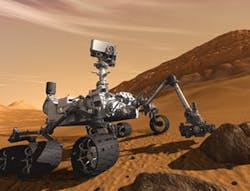JPL chooses Wind River VxWorks real-time software for newest NASA Mars rover
ALAMEDA, Calif., 7 Aug. 2012.NASAJet Propulsion Laboratory’s (JPL’s) Mars Science LaboratoryCuriosityrover, which landed safely on Mars at 10:31 p.m. PDT on 5 Aug. 2012, is the most complex robotic interplanetary probe ever designed--and it is running on Wind River's VxWorks real-time operating system (RTOS), says a company spokesperson.
Curiosity will investigate whether Mars has ever offered environmental conditions favorable for microbial life, and assess Mars’ habitability for future human exploration. VxWorks provided the core operating system for the spacecraft control system, from the moment the rocket left Earth on 26 Nov. 2011 until completion of the mission.
Curiosity relied on VxWorks for the complex landing sequence, called EDL (entry, descent, and landing) and referred to as “seven minutes of terror” given the precision required for the spacecraft to survive the landing, the spokesperson explains. While on Mars, Curiosity will employ VxWorks to perform mission-critical tasks, such as ground operations control, data collection, and Mars-to-Earth communication relay.
“For more than two decades, Wind River’s reliable and secure software has served as a key foundational technology for aerospace organizations globally, and we are extremely proud to continue our legacy as a technology provider for NASA JPL’s space programs.”,” said Ken Klein, president of Wind River.

Courtney Howard | Executive Editor
Courtney, as executive editor, enjoys writing about all things electronics and avionics in PennWell’s burgeoning Aerospace and Defense Group, which encompasses Military & Aerospace Electronics, Avionics Intelligence, the Avionics Europe conference, and much more. She’s also a self-proclaimed social-media maven, mil-aero nerd, and avid avionics geek. Connect with Courtney at [email protected], @coho on Twitter, and on LinkedIn.

